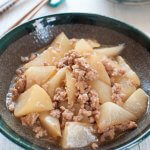
A Simpley braised white radish (daikon) becomes a surprisingly tasty dish when cooked in a thick soy sauce flavoured sauce with pork mince (ground pork). Daikon is cooked until it becomes semi-transparent and tender. The thick sauce has a typical Japanese flavour with dashi, soy sauce, sake, mirin and sugar.
- 400 g (0.9lb) daikon (white radish) cut into bite size rangiri (roll cutting, note 1)
- A handful of rice
- 250 g (0.6lb) pork or chicken mince (ground pork or chicken)
- 1 tsp oil
- 1 cup (250ml/8.5oz) dashi stock (note 2)
- 2 tbsp (40ml/1.4oz) soy sauce
- 1 tbsp (20ml/0.7oz) each sake, mirin
- ½ tbsp sugar
- 1 tsp heap of grated ginger
- ½ tbsp corn flour (corn starch) diluted in ½ tbsp water
-
Place daikon and rice in a pot (note 4) , then add water, enough to cover daikon.
-
Boil for 10 minutes or until daikon is nearly cooked through (a bamboo skewer can get through the daikon). Drain hot water, and run cold water to rinse quickly with cold water , then and drain well.
-
Heat oil in a deep frypan over medium heat, add pork/chicken mince and fry, breaking the lumps. Cook until the meat changes colour to pale brown.
-
Add daikon and stir. Add the remaining ingredients, except corn flour with water, and place a drop lid (note 3) over to cover the surface.
-
When it starts boiling, reduce the heat to low and cook for 10 minutes.
-
Remove the drop lid, add corn flour with water and mix well.
-
When the sauce is thickened, turn the heat off and serve immediately.
1. Step-by-step photos of rangiri (roll cutting) are found in my recipe, Sweet and Sour Pork Meatballs (Subuta), using a carrot as an example.
Because daikon is rather thick, unlike carrot, I firstly cut it vertically into 4 equal size sticks. Then cut each stick using the rangiri method.
2. Instead of making dashi stock from scratch, you can dilute 1 teaspoon of granular dashi stock powder in 250ml (8.5oz) water.
You can buy granular dashi stock at Japanese/Asian grocery stores. You will find details and sample photo of stock powder in Home Style Japanese Dashi Stock.
3. A drop lid is called 'otoshi buta' (落し蓋) in Japanese. It is a round lid that is slightly smaller than the opening of a saucepan. It is traditionally made of wood but I have a stainless steel lid. It is placed on top of the ingredients in a pot to ensure the heat is evenly distributed, ingredients cook faster, and stay in place without breaking apart. It also stops the liquid from evaporating quickly.
If you don’t have a drop lid, you can make one with aluminium foil or baking paper. Cut a square out of foil/paper, trim the edges to make it a round shape with the diameter slightly smaller than the pot. Then poke the foil/paper with a knife or a chopstick to make holes in several places.
4. Boiling daikon with rice serves two purposes – (1) it allows daikon to absorb flavours more easily, and (2) it eliminates bitterness and brings out the sweetness in the daikon.